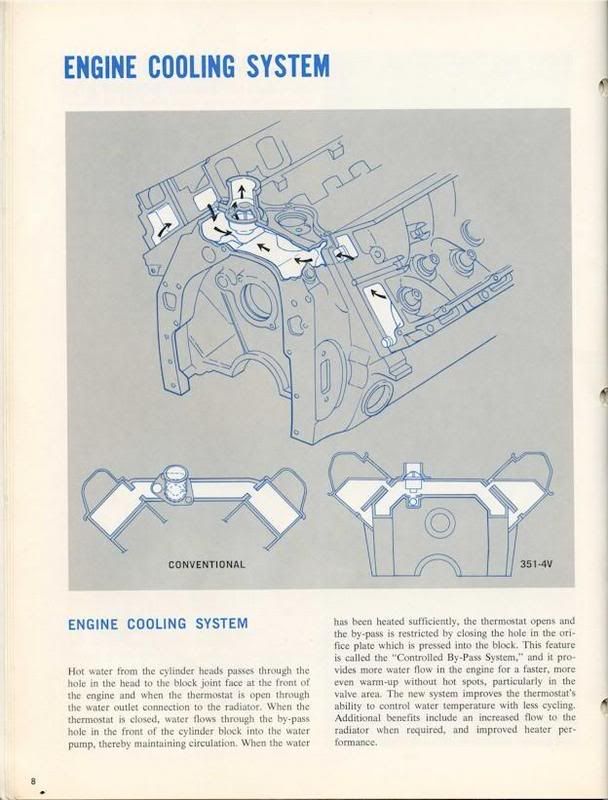If you are going to run with no thermostat at all, then you should NOT drill out the passage in the Weiand pump, leave it blocked to prevent excessive coolant recirculation and the overheating it will definitely cause. Running with no thermostat & the recirc passage blocked is no problem, it will just take the motor a much longer time to warm up.
If you are going to use the Weiand pump AND a Windsor thermostat you have 3 alternatives. You can drill a few small holes in the Windsor thermostat disk, thereby allowing a small amount of coolant to circulate even when it is fully closed; hopefully enough circulation to prevent hot spots in the heads. You can also drill a small hole in the recirc passage of the Weiand coolant pump (perhaps 1/4"), and allow a small amount of coolant to recirculate via the proper passage. As a third remedy you can remember to open your heater valve when you cold start the motor, the coolant will then recirc through the heater core circuit.

When there is no provision for coolant recirculation (such as when using a Weiand coolant pump with its recirc passage left undrilled) and any thermostat is installed (a Windsor OR Cleveland thermostat) and no other method of cold-start recirculation of coolant is used, an unfavorable situation is created during cold starts. When the motor is cold & the thermostat is closed, the coolant pump has no place to discharge, it is pumping against a dead head, no coolant is circulating. Steam builds up in pockets in the head, the head develops hot spots. There is NO cooling going on. Enough hot coolant eventually reaches the thermostat that it finally opens, a surge of cold coolant flows into the heads and thermally shocks them, once the cold coolant reaches the thermostat, it rapidly closes again, the pump is again dead headed, steam again builds up in the heads. This scenario will go on for several cycles until the coolant warms up enough that the thermostat no longer closes completely.
Some owners question, why does air collect in my cooling system? That's not air, that's steam. Others question why does my motor make a gurgling sound when its cold? steam! Finally a few owners ask if the pulsing of the temperature gage from cold to hot and back to cold is normal when the motor is heating up? NO! That's your motor being thermally shocked.
I don't blame anyone for being confused about what is right and what isn't. I worked on Mustangs & Torinos in the '70s & '80s, and the confusion already existed back then, when these motors were new. Mis-information about the Cleveland cooling system has been around since the very beginning. The biggest fallacy was of course that the Windsor and Cleveland used the same thermostat. Look at the picture from the Ford pamphlet above, they specifically show the Robertshaw style thermostat with the cup shaped bottom.
The 351C 4V motor was a high performance motor designed for mass production. The ports in those cylinder heads incorporate design features that the majority of folks have never realized were there, the design was never documented very well. But those PRODUCTION heads will support 750 bhp! The "little" 2V heads will support 500 BHP. Most cam grinders never understood how to grind cams for the 4V heads, and the shoddy performance of many of the aftermarket cams for the Cleveland was evidence of this. The block had an internal dry sump system developed for it, no other Ford V8 was designed with that possibility. Ford racers were running 405 cubic inch all aluminum Clevelands circa 1969 (Dan is that the right date?). Bill Gay & his crew had a lot of high performance plans for the 351C, plans that were all shelved when Ford pulled the plug on its racing programs and the total performance era. The point I want to make is the cooling system is also more advanced than any other cooling system any American manufacturer was using at that time. It incorporates a thermostat unlike any thermostat used in any other V8 of that era. It is designed to flow (recirculate) a greater amount of coolant during warm up to warm the motor up faster, more evenly and to prevent hot spots, it is also designed to flow more coolant during normal operation too.
Back in the '70s & '80s (when 335 series motors were still produced in the US and still installed in current model year cars) I had Ford parts counter people give me the wrong thermostat over the counter. They reasoned the Cleveland was a "small block just like the Windsor" therefore the windsor thermostat would work. They didn't even check their parts book, the know-it-alls just grabbed a Windsor thermostat off the shelf and tried to sell it to me. More than once. Ack! Forget about trying to buy the right part from a generic auto parts store.
Before the advent of the Internet the word about where to acquire the Robertshaw thermostat was not widespread, and many people were left with no other choice than to make the Windsor thermostat work. This is when all the remedies we've mentioned originated. Now we have the internet, the word about the Robertshaw thermostat has been spreading since at least 2001 that I know of. There's no reason to revert to the old tricks any longer, we can buy the correct parts and make the cooling system work as designed.
cowboy from hell

